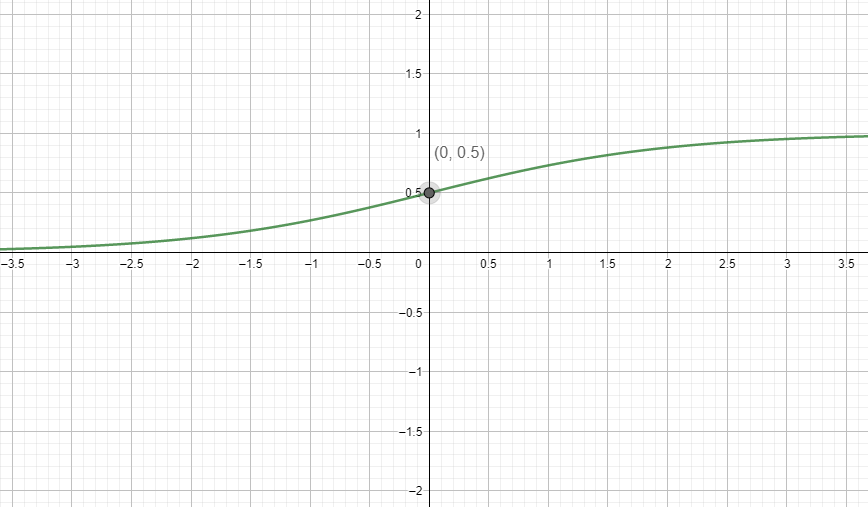
How do you sketch the curve $f\left( x \right)=\dfrac{{{e}^{x}}}{1+{{e}^{x}}}$?
Answer
536.1k+ views
Hint: Now to find the graph of the curve we will find the first derivative of the function and check if the function is increasing or decreasing. Now we will again differentiate to find the second derivative and find if the function is concave upwards or concave downwards. Now we will also find the t intercept by substituting x = 0 and hence we can easily draw a graph of the given function.
Complete step by step solution:
Now let us consider the given function $f\left( x \right)=\dfrac{{{e}^{x}}}{1+{{e}^{x}}}$
First let us check the nature of the function.
Now we will check if the function is increasing or decreasing.
Now we know that if $f\left( x \right)=\dfrac{g}{h}$ then $f'\left( x \right)=\dfrac{hg'-gh'}{{{h}^{2}}}$
Hence using this we get,
$f'\left( x \right)=\dfrac{{{e}^{x}}\left( 1+{{e}^{x}} \right)-{{e}^{x}}\left( {{e}^{x}} \right)}{{{\left( 1+{{e}^{x}} \right)}^{2}}}$
Hence we get,
\[\begin{align}
& \Rightarrow f'\left( x \right)=\dfrac{{{e}^{x}}\left( 1+{{e}^{x}}-{{e}^{x}} \right)}{{{\left( 1+{{e}^{x}} \right)}^{2}}} \\
& \Rightarrow f'\left( x \right)=\dfrac{{{e}^{x}}}{\left( 1+{{e}^{x}} \right)} \\
\end{align}\]
Hence we can say that $f'\left( x \right)>0$ for all x.
Now let us check the second derivative of the function. Hence again differentiating the function we get,
$\begin{align}
& \Rightarrow f''\left( x \right)=\dfrac{{{e}^{x}}{{\left( 1+{{e}^{x}} \right)}^{2}}-2{{e}^{x}}\left( 1+{{e}^{x}} \right)}{{{\left( 1+{{e}^{x}} \right)}^{4}}} \\
& \Rightarrow f''\left( x \right)=\dfrac{{{e}^{x}}\left( 1+{{e}^{x}} \right)\left[ 1+{{e}^{x}}-2 \right]}{{{\left( 1+{{e}^{x}} \right)}^{4}}} \\
\end{align}$
$\Rightarrow f''\left( x \right)=\dfrac{{{e}^{x}}\left( {{e}^{x}}-1 \right)}{\left( 1+{{e}^{x}} \right)}$
Now we know that ${{e}^{x}}>1,x<0$ and ${{e}^{x}}<1,x>0$
Hence $f''\left( x \right)>0$ for $x\in \left( -\infty ,0 \right)$ and $f''\left( x \right)<0$ for $x\in \left( 0,\infty \right)$
Hence function is concave upwards for $x\in \left( -\infty ,0 \right)$ and the function is concave downwards for $x\in \left( 0,\infty \right)$
Now we on substituting x = 0 in the given function we get,
$\Rightarrow f\left( x \right)=\dfrac{{{e}^{0}}}{1+{{e}^{0}}}=\dfrac{1}{2}$
Hence the point (0, 0.5) lies on the graph and is the y intercept of the graph.
Hence now we have a general idea of the graph. Now plotting according to the obtained conditions we get the graphs as,

Note: Now note that here we got the function as purely increasing. It is possible that the function is increasing and decreasing depending on the intervals taken. Hence we can find these intervals in the first derivative test itself. Also note that if the first derivative is 0 then we get an extrema in the function.
Complete step by step solution:
Now let us consider the given function $f\left( x \right)=\dfrac{{{e}^{x}}}{1+{{e}^{x}}}$
First let us check the nature of the function.
Now we will check if the function is increasing or decreasing.
Now we know that if $f\left( x \right)=\dfrac{g}{h}$ then $f'\left( x \right)=\dfrac{hg'-gh'}{{{h}^{2}}}$
Hence using this we get,
$f'\left( x \right)=\dfrac{{{e}^{x}}\left( 1+{{e}^{x}} \right)-{{e}^{x}}\left( {{e}^{x}} \right)}{{{\left( 1+{{e}^{x}} \right)}^{2}}}$
Hence we get,
\[\begin{align}
& \Rightarrow f'\left( x \right)=\dfrac{{{e}^{x}}\left( 1+{{e}^{x}}-{{e}^{x}} \right)}{{{\left( 1+{{e}^{x}} \right)}^{2}}} \\
& \Rightarrow f'\left( x \right)=\dfrac{{{e}^{x}}}{\left( 1+{{e}^{x}} \right)} \\
\end{align}\]
Hence we can say that $f'\left( x \right)>0$ for all x.
Now let us check the second derivative of the function. Hence again differentiating the function we get,
$\begin{align}
& \Rightarrow f''\left( x \right)=\dfrac{{{e}^{x}}{{\left( 1+{{e}^{x}} \right)}^{2}}-2{{e}^{x}}\left( 1+{{e}^{x}} \right)}{{{\left( 1+{{e}^{x}} \right)}^{4}}} \\
& \Rightarrow f''\left( x \right)=\dfrac{{{e}^{x}}\left( 1+{{e}^{x}} \right)\left[ 1+{{e}^{x}}-2 \right]}{{{\left( 1+{{e}^{x}} \right)}^{4}}} \\
\end{align}$
$\Rightarrow f''\left( x \right)=\dfrac{{{e}^{x}}\left( {{e}^{x}}-1 \right)}{\left( 1+{{e}^{x}} \right)}$
Now we know that ${{e}^{x}}>1,x<0$ and ${{e}^{x}}<1,x>0$
Hence $f''\left( x \right)>0$ for $x\in \left( -\infty ,0 \right)$ and $f''\left( x \right)<0$ for $x\in \left( 0,\infty \right)$
Hence function is concave upwards for $x\in \left( -\infty ,0 \right)$ and the function is concave downwards for $x\in \left( 0,\infty \right)$
Now we on substituting x = 0 in the given function we get,
$\Rightarrow f\left( x \right)=\dfrac{{{e}^{0}}}{1+{{e}^{0}}}=\dfrac{1}{2}$
Hence the point (0, 0.5) lies on the graph and is the y intercept of the graph.
Hence now we have a general idea of the graph. Now plotting according to the obtained conditions we get the graphs as,

Note: Now note that here we got the function as purely increasing. It is possible that the function is increasing and decreasing depending on the intervals taken. Hence we can find these intervals in the first derivative test itself. Also note that if the first derivative is 0 then we get an extrema in the function.
Recently Updated Pages
A man running at a speed 5 ms is viewed in the side class 12 physics CBSE

The number of solutions in x in 02pi for which sqrt class 12 maths CBSE

State and explain Hardy Weinbergs Principle class 12 biology CBSE

Write any two methods of preparation of phenol Give class 12 chemistry CBSE

Which of the following statements is wrong a Amnion class 12 biology CBSE

Differentiate between action potential and resting class 12 biology CBSE

Trending doubts
What are the major means of transport Explain each class 12 social science CBSE

Which are the Top 10 Largest Countries of the World?

Draw a labelled sketch of the human eye class 12 physics CBSE

Explain sex determination in humans with line diag class 12 biology CBSE

Explain sex determination in humans with the help of class 12 biology CBSE

Differentiate between homogeneous and heterogeneous class 12 chemistry CBSE




